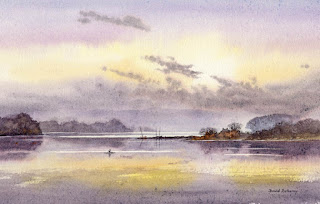Don’t you wish sometimes that life could be really dull, drab and boring? It can get a little too exciting for much of the time, leaving you breathless and with no time to sit back and recall all the fun you’ve had. Being out on the hills tends to energise me and is far more pleasant than sitting in the studio, especially when you have to listen to the racket of builders across the road with their loud radios and screaming stone-cutters. And I usually take a cappuccino and Danish pastry out with me anyway – it’s amazing how it helps the washes flow across the paper!
When I went out recently on the Brecon Beacons, I took with me some small sample sheets of the new Saunders Waterford High-White hot-pressed paper from St Cuthberts Mill. It really is delightfully smooth and as one would expect with St Cuthberts, it takes the washes well. As you can see in the rough sketch, the snow really does stand out on this paper. Note how the terracing of the rock outcrops appears in broken horizontal lines, with a few gullies sweeping down here and there. It’s important to spend a few moments observing these aspects as they give a marvellous sense of place in your work. This paper also works well for wash and line work, and should be in the art shops fairly soon. I can’t wait to work on some big sheets.
I shall be demonstrating at Patchings Art Festival next month in the St Cuthberts Mill marquee, on the 9th, 10th and 11th June, so I hope you can come along and enjoy the event. It’s always a great pleasure to be there, with so many artists and crafts-people, and of course, all the materials to check out. And make sure you try out some of the Waterford HP paper!




 The lay-flat sketchbook is made up of the superb
The lay-flat sketchbook is made up of the superb 